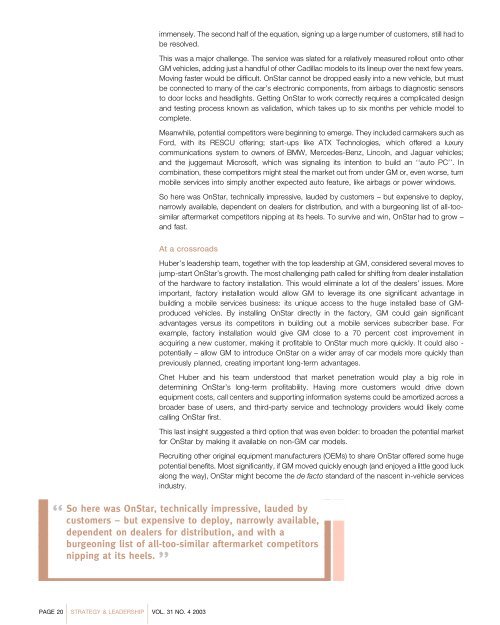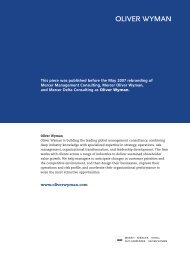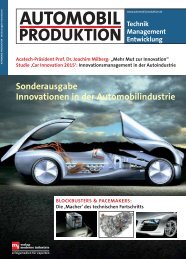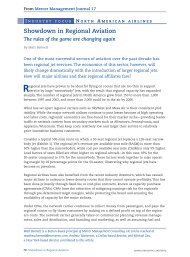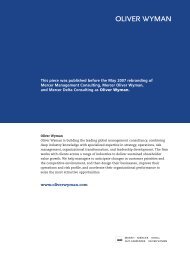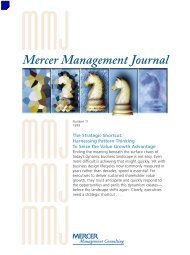Demand innovation: GM's OnStar case - Oliver Wyman
Demand innovation: GM's OnStar case - Oliver Wyman
Demand innovation: GM's OnStar case - Oliver Wyman
Create successful ePaper yourself
Turn your PDF publications into a flip-book with our unique Google optimized e-Paper software.
immensely. The second half of the equation, signing up a large number of customers, still had to<br />
be resolved.<br />
This was a major challenge. The service was slated for a relatively measured rollout onto other<br />
GM vehicles, adding just a handful of other Cadillac models to its lineup over the next few years.<br />
Moving faster would be difcult. <strong>OnStar</strong> cannot be dropped easily into a new vehicle, but must<br />
be connected to many of the car’s electronic components, from airbags to diagnostic sensors<br />
to door locks and headlights. Getting <strong>OnStar</strong> to work correctly requires a complicated design<br />
and testing process known as validation, which takes up to six months per vehicle model to<br />
complete.<br />
Meanwhile, potential competitors were beginning to emerge. They included carmakers such as<br />
Ford, with its RESCU offering; start-ups like ATX Technologies, which offered a luxury<br />
communications system to owners of BMW, Mercedes-Benz, Lincoln, and Jaguar vehicles;<br />
and the juggernaut Microsoft, which was signaling its intention to build an ‘‘auto PC’’. In<br />
combination, these competitors might steal the market out from under GM or, even worse, turn<br />
mobile services into simply another expected auto feature, like airbags or power windows.<br />
So here was <strong>OnStar</strong>, technically impressive, lauded by customers – but expensive to deploy,<br />
narrowly available, dependent on dealers for distribution, and with a burgeoning list of all-toosimilar<br />
aftermarket competitors nipping at its heels. To survive and win, <strong>OnStar</strong> had to grow –<br />
and fast.<br />
‘‘<br />
At a crossroads<br />
Huber’s leadership team, together with the top leadership at GM, considered several moves to<br />
jump-start <strong>OnStar</strong>’s growth. The most challenging path called for shifting from dealer installation<br />
of the hardware to factory installation. This would eliminate a lot of the dealers’ issues. More<br />
important, factory installation would allow GM to leverage its one signicant advantage in<br />
building a mobile services business: its unique access to the huge installed base of GMproduced<br />
vehicles. By installing <strong>OnStar</strong> directly in the factory, GM could gain signicant<br />
advantages versus its competitors in building out a mobile services subscriber base. For<br />
example, factory installation would give GM close to a 70 percent cost improvement in<br />
acquiring a new customer, making it protable to <strong>OnStar</strong> much more quickly. It could also -<br />
potentially – allow GM to introduce <strong>OnStar</strong> on a wider array of car models more quickly than<br />
previously planned, creating important long-term advantages.<br />
Chet Huber and his team understood that market penetration would play a big role in<br />
determining <strong>OnStar</strong>’s long-term protability. Having more customers would drive down<br />
equipment costs, call centers and supporting information systems could be amortized across a<br />
broader base of users, and third-party service and technology providers would likely come<br />
calling <strong>OnStar</strong> rst.<br />
This last insight suggested a third option that was even bolder: to broaden the potential market<br />
for <strong>OnStar</strong> by making it available on non-GM car models.<br />
Recruiting other original equipment manufacturers (OEMs) to share <strong>OnStar</strong> offered some huge<br />
potential benets. Most signicantly, if GM moved quickly enough (and enjoyed a little good luck<br />
along the way), <strong>OnStar</strong> might become the de facto standard of the nascent in-vehicle services<br />
industry.<br />
So here was <strong>OnStar</strong>, technically impressive, lauded by<br />
customers – but expensive to deploy, narrowly available,<br />
dependent on dealers for distribution, and with a<br />
burgeoning list of all-too-similar aftermarket competitors<br />
nipping at its heels.<br />
’’<br />
PAGE 20<br />
|<br />
STRATEGY & LEADERSHIP<br />
|<br />
VOL. 31 NO. 4 2003


